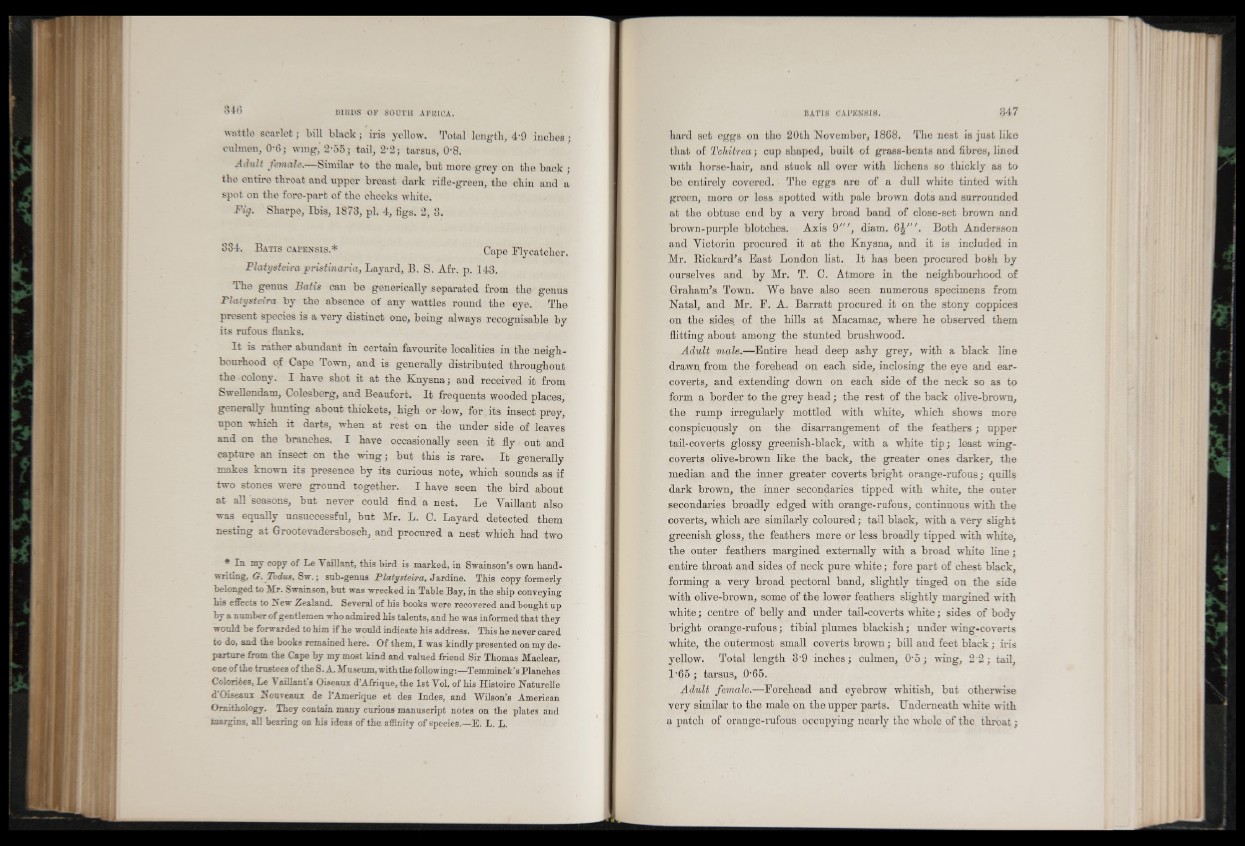
wattle scarlet ; bill black ; iris yellow. Total length, 4-9 inches ;
euhnen, 0*6; wmg, 2’55; tail, 2‘2; tarsus, 0'8.
Adult female.—Similar to the male, but more grey on the back •
the entire throat and upper breast dark rifle-green, the ohin and a
spot on the fore-part of the cheeks white.
Fig. Sharpe, Ibis, 1878, pi. 4, figs. 2, 3.
884. B a t is c a f e n s is * Cape Flycatcher.
Platysteira pristinana, Layard, B. S. Afr. p. 148.
The genus Batis can be generically separated from the genus
Platysteira by the absence of any wattles round the eye. The
present species is a very distinct one, being always recognisable by
its rufous flanks.
I t is rather abundant in certain favourite localities in the neighbourhood
of Cape Town, and is generally distributed throughout
the colony. I have shot it at the Knysna; and received it from
Swellendam, Colesberg, and Beaufort. I t frequents wooded places,
generally hunting about thickets, high or -low, for its insect prey,
upon which it darts, when at rest on the under side of leaves
and on the branches. I have occasionally seen it fly out and
capture an insect on the wing; but this is rare. It generally
makes known its presence by its curious note, which sounds as if
two stones were ground together. I have seen the bird about
at all seasons, but never could find a nest. Le Vaillant also
was equally unsuccessful, but Mr. L. C. Layard detected them
nesting at Grootevadersbosch, and procured a nest which had two
* In my copy o f L e V a illa n t, th is b ird is marked, in Swainson’s own hand-
w n tin g , G. Todus, Sw. ; sub-genus Platysteira, Ja rd in e . T his copy form erly
belonged to M r. Swainson, b u t was wrecked in T able B a y , in the ship conveying
h is effects to hi ew Zealand. Several o f h is books were recovered and bought up
b y a number o f gentlemen who admired h is talents, and he was informed th a t they
would be forwarded to him i f he would indicate h is address. T h is he never cared
to do, and the books remained here. O f them, I was k in d ly presented on my departure
from the Cape b y my most k in d and valued frien d S ir Thomas M aclear,
one o f the trustees o f the S. A . Museum, w ith the follow ing :— Tem m inck’s Planches
Coloriées, L e Y a flla n t’s Oiseaux d’A friq u e , the 1st V o l o f h is H is to ire N a tu re lle
d ’Oiseaux Nouveaux de PAm erique et des Indes, and W ilso n ’s Am erican
O rn ith olog y . T hey contain many curious m anuscript notes on the plates and
margins, a ll bearing on h is ideas o f the. a ffin ity o f species.—E . L . L .
bard set eggs on the 20th November, 1868. The nest is just like
that of Tchitrea; cup shaped, built of grass-bents and fibres, lined
with horse-hair, and stuck all over with lichens so thickly as to
be entirely covered. The eggs are of a dull white tinted with
green, more or less spotted with pale brown dots and surrounded
at the obtuse end by a very broad band of close-set brown and
brown-purple blotches. Axis 9 , diam. 6^'". Both Andersson
and Victorin procured it at the Knysna, and it is included in
Mr. Rickard’s Bast London list. It has been procured both by
ourselves and by Mr. T. 0. Atmore in the neighbourhood of
Graham’s Town. We have also seen numerous specimens from
Natal, and Mr. F. A. Barratt procured it on the stony coppices
on the sides, of the hills at Macamac, where he observed them
flitting about among the stunted brushwood.
Adult male.—Entire head deep ashy grey, with a black line
drawn from the forehead on each side, inclosing the eye and ear-
coverts, and extending down on each side of the neck so as to
form a border to the grey head; the rest of the back olive-brown,
the rump irregularly mottled with white, which shows more
conspicuously on the disarrangement of the feathers; upper
tail-coverts glossy greenish-black, with a white tip; least wing-
coverts olive-brown like the back, the greater ones darker, the
median and the inner greater coverts bright orange-rufous; quills
dark brown, the inner secondaries tipped with white, the outer
secondaries broadly edged with orange-rufous, continuous with the
coverts, which are similarly coloured; tail black, with a very slight
greenish gloss, the feathers more or less broadly tipped with white,
the outer feathers margined externally with a broad white line;
entire throat and sides of neck pure white; fore part of chest black,
forming a very broad pectoral band, slightly tinged on the side
with olive-brown, some of the lower feathers slightly margined with
white; centre of belly and under tail-coverts white; sides of body
bright orange-rufous; tibial plumes blackish; under wing-coverts
white, the outermost small coverts brown; bill and feet black; iris
yellow. Total length 3'9 inches; culmen, 0’5 ; wing, 2'2; tail,
1‘65; tarsus, 0-65.
Adult female.—Forehead and eyebrow whitish, but otherwise
very similar to the male on the upper parts. Underneath white with
a patch of orange-rufous occupying nearly the whole of the throat;